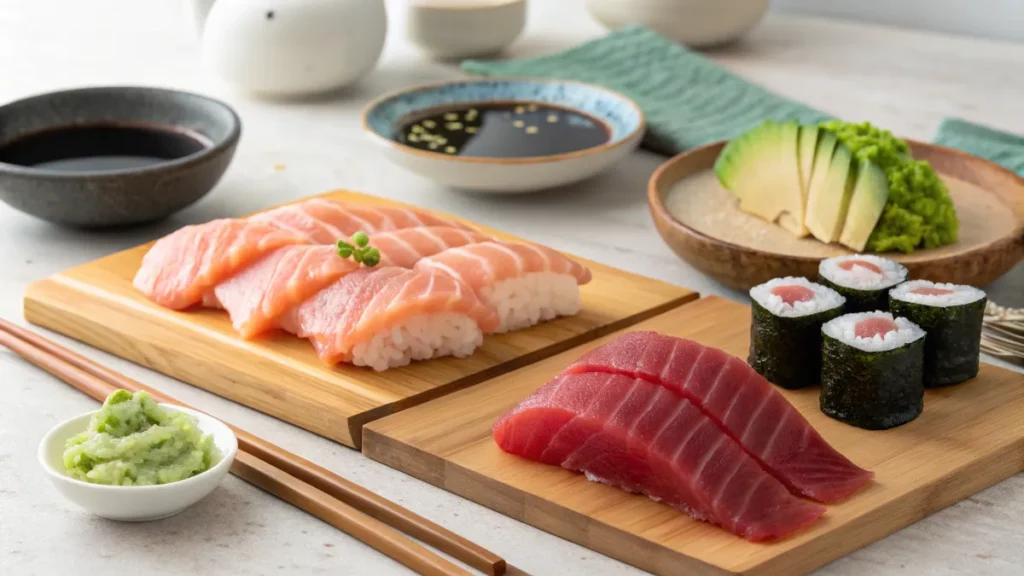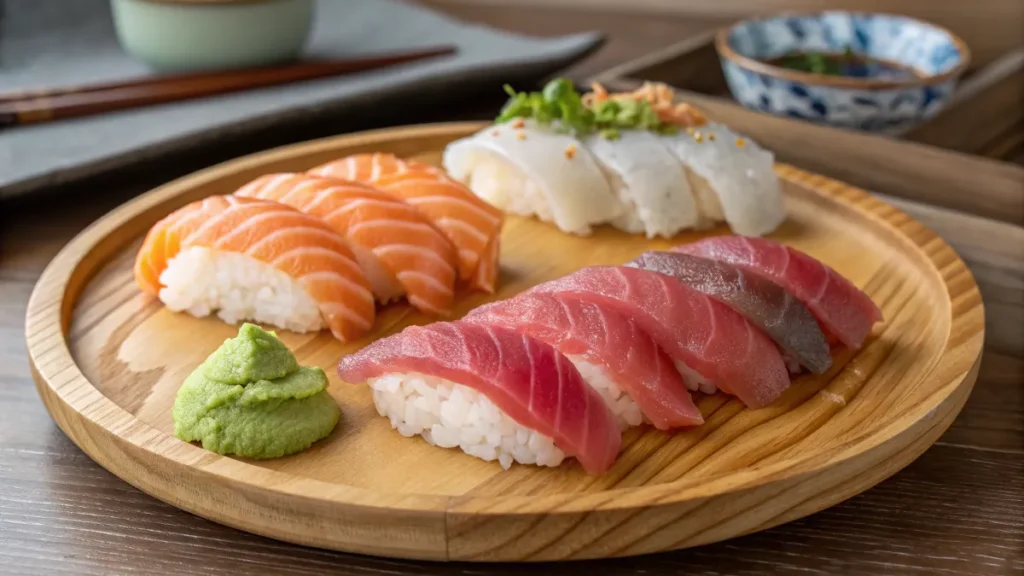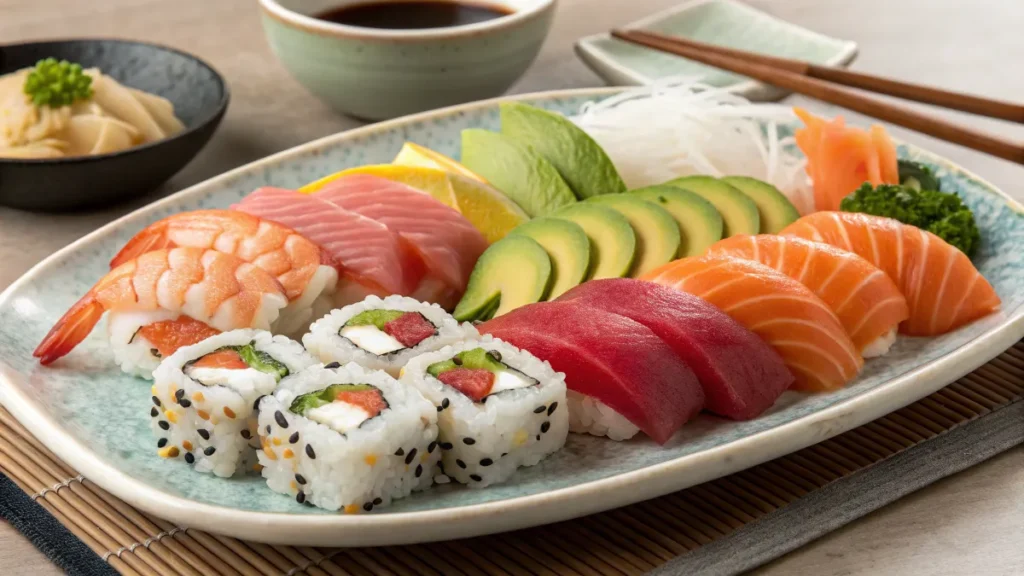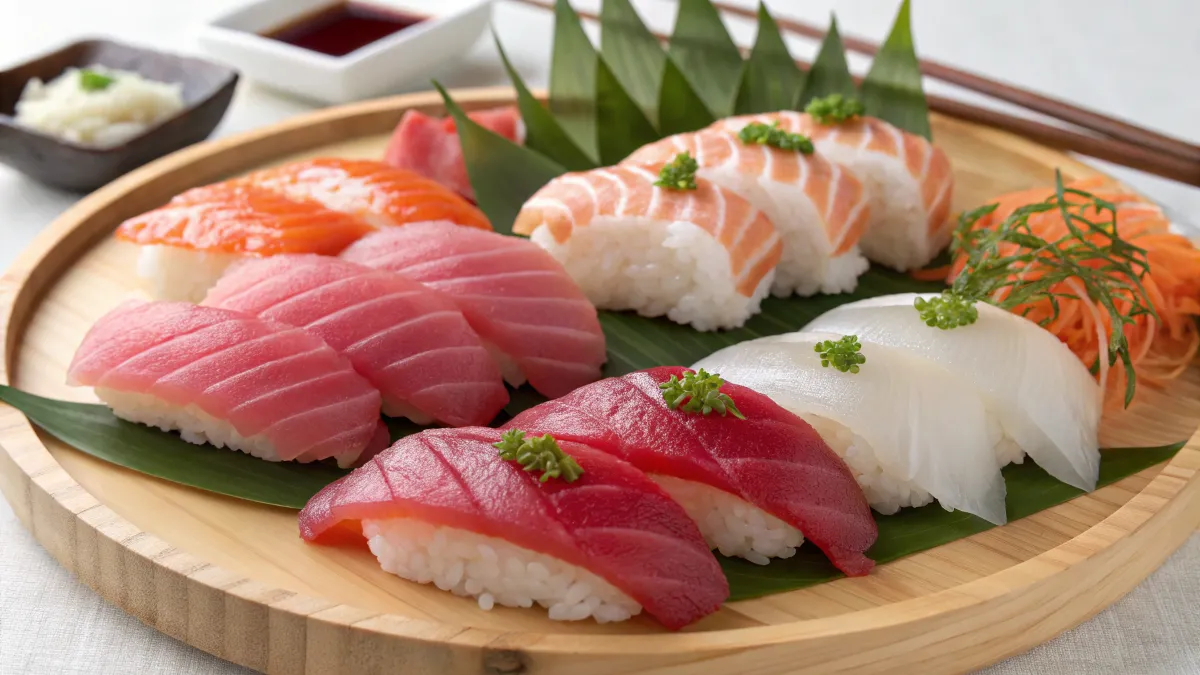Sashimi and nigiri are two iconic dishes in Japanese cuisine, often compared by food lovers. If you’ve ever wondered about the key differences between sashimi vs nigiri, this guide will explain everything. From ingredients and taste to nutritional benefits and cultural significance, we’ll help you decide which dish suits your palate. Whether you’re dining out or exploring Japanese recipes at home, understanding these dishes can enhance your culinary journey.
What is Sashimi and Nigiri?
When exploring Japanese food culture, sashimi and nigiri are must-try dishes. They showcase the simplicity and elegance of fresh ingredients.
What Is Sashimi?
Sashimi is a traditional Japanese dish consisting of thinly sliced raw fish or seafood. Unlike sushi, it is served without rice. The term sashimi translates to “pierced body,” reflecting its origins in freshly prepared fish. This dish focuses on the natural flavors of the seafood, requiring exceptional quality and freshness.
Some of the most common types of sashimi include:
- Tuna (Maguro): Known for its smooth, buttery texture.
- Salmon (Sake): A favorite with a rich, fatty flavor.
- Yellowtail (Hamachi): Often chosen for its delicate taste.
Sashimi is typically served with garnishes like shredded daikon radish, shiso leaves, or a dab of wasabi. Dipping it lightly in soy sauce enhances its flavor without overpowering the fish.
What Is Nigiri?
Nigiri, short for nigirizushi, is a type of sushi that combines hand-pressed rice with a slice of raw fish or seafood. The rice is lightly seasoned with vinegar, giving it a tangy flavor that complements the fish.
Unlike sashimi, nigiri is more about the balance between the rice and fish. Sometimes, chefs add a small amount of wasabi between the rice and the fish or top the nigiri with ingredients like seaweed, scallions, or a thin soy glaze.
Popular types of nigiri include:
- Shrimp (Ebi): Sweet and firm in texture.
- Freshwater Eel (Unagi): Often grilled with a sweet soy-based sauce.
- Egg (Tamago): A sweet, custard-like omelet served on rice.
Nigiri is usually eaten in one bite, allowing the flavors of the rice and fish to blend perfectly.
Key Differences Between Sashimi vs Nigiri
Sashimi and nigiri may look similar at first glance, but they differ in several keyways. From ingredients to presentation, understanding these differences helps appreciate each dish’s unique character.
Ingredients in Sashimi vs Nigiri

The ingredients in sashimi and nigiri define their core differences. Sashimi relies solely on fresh, raw seafood or fish. The focus is entirely on the quality of the fish, with no additional components like rice or seaweed.
On the other hand, nigiri is more about balance. It pairs raw fish or seafood with hand-pressed, vinegared rice. Some versions of nigiri include toppings like thin nori strips or garnishes such as scallions.
For tips on selecting fresh fish for sashimi, check out BBC Good Food’s guide to preparing raw fish. Similarly, AllRecipes explains the basics of making sushi rice essential for nigiri preparation.
If you’re wondering how to pick the freshest fish, check out our guide on Why Langoustines Are Better Than Lobster.
Preparation Styles of Sashimi vs Nigiri
The preparation of sashimi emphasizes precision. Chefs use sharp knives to slice the fish into thin, delicate pieces. Each slice is arranged artfully on a plate, often accompanied by daikon radish and shiso leaves for added texture and flavor.
Nigiri preparation is equally meticulous but more complex. First, chefs prepare the sushi rice, carefully seasoning it with vinegar. Then, they hand-shape the rice into small oval mounds. A slice of fish is placed on top, sometimes with a touch of wasabi or soy glaze.
For a closer look at sushi-making techniques, Bon Appétit provides helpful tips for assembling nigiri at home.
Cultural Context and Usage
Sashimi is often served as an appetizer or a standalone dish. Its simplicity allows diners to appreciate the quality of the seafood without distractions. Nigiri, however, is commonly part of a sushi platter or meal. It offers a harmonious blend of rice and fish, making it more filling than sashimi.
Understanding these differences in ingredients, preparation, and cultural use makes it easier to see why people often compare sashimi vs nigiri when choosing what to order.
Taste and Texture Comparisons
Taste and texture are two essential factors that separate sashimi from nigiri. Each dish has a unique sensory appeal that reflects its ingredients and preparation.
Flavor Profiles
Sashimi is all about purity. The taste focuses entirely on the fish or seafood. Depending on the type of sashimi, you may experience a buttery richness (like salmon), a clean, delicate flavor (like flounder), or a robust, meaty taste (like tuna). Chefs aim to enhance, not mask, the fish’s natural flavor.
In contrast, nigiri combines flavors. The vinegared rice adds a tangy element that complements the fish. Some varieties, like unagi nigiri, may include sweet soy glaze for an added layer of flavor. These combinations make nigiri a more dynamic eating experience.
Delish offers creative ideas for sushi toppings, including ways to enhance nigiri’s flavor.
Texture Differences
The texture of sashimi is silky and tender. High-quality fish melts in your mouth, creating a luxurious dining experience. Each bite highlights the seafood’s smoothness.
Nigiri, however, introduces a mix of textures. The softness of the fish contrasts with the slight stickiness of the rice. This pairing creates a satisfying bite that feels more substantial than sashimi.
If you’re interested in creating perfect textures for nigiri at home, Epicurious shares essential techniques for shaping sushi rice.
Health Benefits and Nutritional Facts
Sashimi and nigiri offer a variety of health benefits, making them popular among seafood lovers. However, their nutritional profiles differ due to their ingredients.
Nutritional Overview of Sashimi
Sashimi is low in calories and high in protein. It’s packed with omega-3 fatty acids, essential for brain and heart health. The absence of rice makes sashimi a carb-free choice, perfect for those on keto or low-carb diets.
Common nutritional highlights of sashimi include:
- Protein: Builds muscle and repairs tissues.
- Omega-3 Fatty Acids: Improve cardiovascular health and reduce inflammation.
- Vitamins and Minerals: Rich in vitamin D, selenium, and iodine.
For a detailed guide on the benefits of eating fresh seafood, Bon Appétit shares tips for selecting and serving sashimi-grade fish.
For more creative dinner ideas to try on a Friday night, you might enjoy exploring dinner category.
Nutritional Overview of Nigiri
Nigiri combines the benefits of seafood with vinegared rice, offering a balance of protein and carbohydrates. While slightly higher in calories than sashimi, it provides energy from the rice, making it a more filling option.
Key nutritional aspects of nigiri include:
- Carbs: Energy for the body, thanks to the rice.
- Protein: Found in the fish or seafood topping.
- Vinegar in Rice: Contains acetic acid, which aids digestion.
Nigiri is an excellent option for those seeking a light yet satisfying meal. Delish provides creative ideas to enhance traditional nigiri toppings.
Is Sashimi Healthier Than Nigiri?
When comparing sashimi vs nigiri in terms of health, sashimi is often considered healthier due to its low calorie and carb-free nature. However, nigiri offers a balanced energy source, making it ideal for active individuals. Choosing between the two ultimately depends on your dietary goals.
How to Eat Sashimi and Nigiri Like a Pro
Enjoying sashimi and nigiri correctly not only enhances the experience but also shows respect for the chef’s artistry.
Etiquette for Sashimi
When eating sashimi, less is more. Follow these tips for the best experience:
- Use Chopsticks: Avoid touching the delicate fish with your fingers.
- Dip Lightly: Dip only the edge of the sashimi in soy sauce to avoid overpowering its natural flavor.
- Pair with Wasabi: Add a small amount of wasabi directly to the fish if desired.
Sashimi is best enjoyed with simple garnishes like daikon or shiso. For more tips, visit Epicurious’ guide to plating sashimi like a chef.
Etiquette for Nigiri
Nigiri requires a slightly different approach:
- Use Fingers or Chopsticks: Either method is acceptable.
- Flip and Dip: Turn the nigiri sideways and dip the fish, not the rice, into soy sauce. This prevents the rice from falling apart.
- Eat in One Bite: Enjoy the harmony of flavors by eating nigiri whole.
Mastering the art of eating sashimi vs nigiri enhances appreciation for Japanese cuisine. Whether dining out or preparing at home, proper etiquette makes the experience more enjoyable.
Popular Sashimi vs Nigiri Dishes Around the World
Japanese cuisine offers an array of sashimi and nigiri options, each with unique flavors and styles. From the most beloved choices to regional specialties, there’s something for everyone.
Top Types of Sashimi to Try
Sashimi celebrates the pure essence of seafood, making it a favorite for purists. These are some of the most popular varieties:
- Tuna (Maguro): A classic choice, especially the fatty tuna (otoro), prized for its rich, buttery taste.
- Salmon (Sake): Loved for its smooth texture and mildly sweet flavor.
- Yellowtail (Hamachi): Known for its slightly firm yet delicate consistency.
- Octopus (Tako): Cooked before serving, this option offers a chewy texture and mild taste.
- Squid (Ika): Served raw, it has a creamy texture and subtle flavor.
For tips on preparing sashimi at home, check out Bon Appétit’s guide to handling raw fish.
Popular Nigiri Options
Nigiri, a fusion of rice and seafood, caters to those who enjoy variety. Here are a few crowd favorites:
- Eel (Unagi): Grilled and brushed with a sweet soy-based sauce for added flavor.
- Shrimp (Ebi): Slightly sweet and firm, often cooked before being served.
- Egg (Tamago): A sweet, fluffy omelet slice paired with rice.
- Scallop (Hotate): Delicate and mildly sweet, it’s perfect for first-timers.
- Salmon Roe (Ikura): Bursting with flavor, these orange pearls are both salty and briny.
Whether you prefer the simplicity of sashimi or the layered flavors of nigiri, exploring these dishes is a culinary adventure. For creative ideas, visit Delish’s sushi recipes.
Sashimi vs Nigiri: Price and Accessibility
Understanding the cost and availability of sashimi and nigiri can help you choose what fits your budget and dining preferences.
Cost Differences
Sashimi is often more expensive than nigiri. Why? The fish used in sashimi must be of the highest quality since it’s served raw without any additional ingredients. Premium cuts like otoro (fatty tuna) or uni (sea urchin) can significantly raise the price.
Nigiri, on the other hand, combines fish with rice, making it more economical. The rice balances the meal, allowing chefs to use smaller portions of fish. While high-end nigiri can still be pricey, it’s usually more affordable than sashimi.
Availability in Restaurants and Stores
Finding sashimi often requires visiting specialty sushi restaurants or Japanese grocery stores. Since sashimi relies heavily on freshness, not all places can guarantee the quality needed for this dish.
Nigiri is more widely available, even in casual sushi spots. Many grocery stores offer pre-packaged nigiri sushi for a quick and convenient option. However, if you’re looking for authentic flavors, dining at a reputable sushi bar is worth the extra effort.
Whether you’re debating sashimi vs nigiri based on price or accessibility, both options offer unique dining experiences. Choose what aligns with your taste and budget and enjoy the journey!
Whether you’re dining on a budget, check out What Food is Associated with Fridays? to have more ideas.
FAQs About Sashimi and Nigiri
Many questions arise when comparing sashimi vs nigiri, especially for those new to Japanese cuisine. Here are some frequently asked questions to help you understand these dishes better.
Yes, nigiri is a type of sushi. The term “sushi” refers to any dish that includes vinegared rice, which is a key component of nigiri. Unlike maki (sushi rolls), nigiri is hand-pressed and topped with a slice of fish or seafood. This simple yet elegant presentation makes nigiri a staple in sushi menus worldwide.
Absolutely! With the right tools and fresh ingredients, making sashimi or nigiri at home can be an enjoyable experience. For sashimi, you’ll need a very sharp knife to achieve thin, precise cuts. Nigiri requires cooked sushi rice, a bit of vinegar, and practice shaping the rice into small mounds. Ensure you use high-quality fish labeled as “sashimi-grade” for safety.
For more tips, check out Bon Appétit’s guide to making sushi at home.
The best fish for sashimi depends on your taste. Popular choices include tuna, salmon, and yellowtail. For a milder flavor, try flounder or scallop. Always buy fish that’s labeled as sashimi-grade to ensure freshness and safety.
Yes, vegetarian nigiri is a great option for non-meat eaters. Popular toppings include avocado, cucumber, or tamago (sweet egg omelet). Some chefs even use marinated tofu or pickled vegetables to create unique vegetarian nigiri options.
Table of Comparison
Comparing sashimi vs nigiri side by side highlights their unique qualities. Here’s a quick breakdown:

| Feature | Sashimi | Nigiri |
|---|---|---|
| Ingredients | Raw fish or seafood | Vinegared rice with fish |
| Presentation | Thinly sliced, no rice | Hand-pressed rice with fish |
| Nutritional Value | High protein, no carbs | High protein, moderate carbs |
| Eating Style | Eaten with chopsticks | Eaten with fingers or chopsticks |
| Price Range | Typically higher | Moderate, varies by topping |
This table offers a clear visual to compare the two dishes, helping diners make informed choices based on their preferences.
Regional Variations of Sashimi and Nigiri

Japanese cuisine is rich in regional specialties, and both sashimi and nigiri reflect this diversity.
Unique Sashimi Styles Across Japan
Each region in Japan puts its own spin on sashimi:
- Kyoto: Known for cured and lightly smoked sashimi, such as saba (mackerel).
- Hokkaido: Famous for fresh scallops, uni (sea urchin), and salmon sashimi due to its proximity to abundant seafood.
- Osaka: Sashimi here often includes octopus and other seafood seasoned with unique local sauces.
Regional Nigiri Innovations
Nigiri also varies regionally. In Tokyo, Edomae sushi emphasizes freshness and simplicity, while Osaka offers pressed sushi (oshizushi), which is a layered version of nigiri prepared using a wooden mold.
Adding these unique regional options to your dining list can elevate your culinary experience.
Choosing Between Sashimi and Nigiri
When deciding between sashimi vs nigiri, consider factors like your mood, dietary goals, and the occasion.
- If you’re looking for a light, protein-packed option, sashimi is perfect.
- For a more filling and balanced meal, nigiri offers a satisfying combination of rice and seafood.
To enhance your meal, pair sashimi with a refreshing side salad or enjoy nigiri alongside miso soup. If you’re new to Japanese cuisine, starting with popular options like salmon sashimi or tuna nigiri is a great way to explore these dishes.
If you’re looking for more diversity, check out Empanadas Venezolanas: A Delicious Taste of Venezuela
Conclusion
Sashimi and nigiri are both exquisite examples of Japanese culinary artistry. Sashimi highlights the natural flavors and textures of fresh fish, while nigiri blends the subtle tang of vinegared rice with delicate seafood toppings. Whether you’re a purist savoring sashimi or a sushi lover indulging in nigiri, each dish offers a memorable experience.
So, the next time you’re at a sushi restaurant or planning a Japanese-inspired meal, think about the flavors, textures, and dining style that appeal to you. Whichever you choose, you can’t go wrong with these two iconic dishes.

